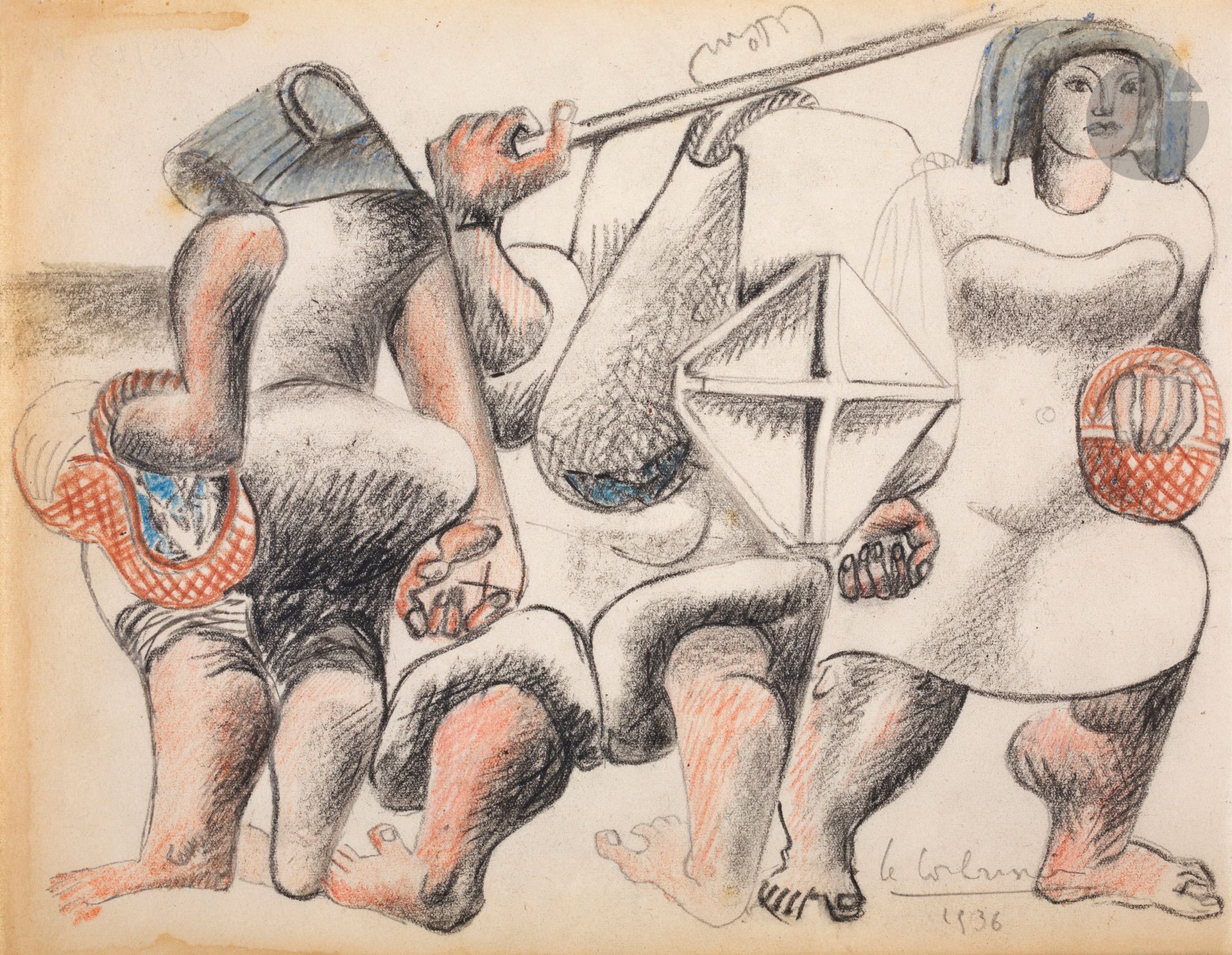Description
Charles-Edouard JEANNERET known as LE CORBUSIER (1887-1965) Three fisherwomen of Arcachon, 1936 Oil pastels and colored pencils on paper. Signed and dated lower right. (Small stains on the left). 21 x 26,6 cm A certificate from Mr. Éric Mouchet, dated February 20, 2023, will be given to the buyer. Three Fisherwomen of Arcachon (1936) is a very interesting drawing in more ways than one: it speaks to us of vacations and thus of private life, of the attraction of vernacular cultures, of the expressiveness of the hands and feet of the figures Le Corbusier paints, and of the "Marriage of Contours. Le Corbusier got married in 1930, and his rhythm of life, previously very studious, now leaves some room for leisure. Like the artistic intelligentsia of the time, notably Jean Cocteau, Le Corbusier and his wife Yvonne spent their vacations in the Arcachon basin, precisely in Piquey. Leisure activities, synonymous with games, dancing, the beach, music and above all friendship, began to invade Le Corbusier's drawings and never left. These vacations were an opportunity to discover local crafts, which legitimately fascinated the architect. Since his youthful travels in 1907 and especially 1911, from which he had brought back many popular ceramics from the Balkans, Le Corbusier regularly expressed this interest in his sketchbooks and notes. As can be seen in this drawing, these fisherwomen are wearing two typical artifacts of the Bay of Arcachon: they are wearing a large, very recognizable headdress, to which Le Corbusier will devote several other drawings, and one of them is carrying on her back a mud skate called a "mastoun" there, used to avoid sinking, and consisting of a large square board that leaves the imprint of the cross in the wet soil, with which its underside is equipped to avoid slipping. Le Corbusier obviously noticed the astonishing design of these successions of crosses printed in the mud of the basin and retranscribed it in certain paintings of the time. On a more stylistic note, we see here again the care the artist took in drawing the feet and hands of the figures, and the power that emanates from them. Finally, this drawing shows some signs of a graphic concept dear to Le Corbusier and which he entitled the "Marriage of contours". It consists of building compositions in which a single line draws two figures, as the architect's pencil line delimits two spaces. The curves of bodies were La Corbusier's favorite motif to put this intellectual exercise into practice during the 1930s. We can see here that the outline of two arms or two legs can be the result of a single stroke, which of course affects the whole composition and requires the artist to have a thorough knowledge of human morphology.
236
Charles-Edouard JEANNERET known as LE CORBUSIER (1887-1965) Three fisherwomen of Arcachon, 1936 Oil pastels and colored pencils on paper. Signed and dated lower right. (Small stains on the left). 21 x 26,6 cm A certificate from Mr. Éric Mouchet, dated February 20, 2023, will be given to the buyer. Three Fisherwomen of Arcachon (1936) is a very interesting drawing in more ways than one: it speaks to us of vacations and thus of private life, of the attraction of vernacular cultures, of the expressiveness of the hands and feet of the figures Le Corbusier paints, and of the "Marriage of Contours. Le Corbusier got married in 1930, and his rhythm of life, previously very studious, now leaves some room for leisure. Like the artistic intelligentsia of the time, notably Jean Cocteau, Le Corbusier and his wife Yvonne spent their vacations in the Arcachon basin, precisely in Piquey. Leisure activities, synonymous with games, dancing, the beach, music and above all friendship, began to invade Le Corbusier's drawings and never left. These vacations were an opportunity to discover local crafts, which legitimately fascinated the architect. Since his youthful travels in 1907 and especially 1911, from which he had brought back many popular ceramics from the Balkans, Le Corbusier regularly expressed this interest in his sketchbooks and notes. As can be seen in this drawing, these fisherwomen are wearing two typical artifacts of the Bay of Arcachon: they are wearing a large, very recognizable headdress, to which Le Corbusier will devote several other drawings, and one of them is carrying on her back a mud skate called a "mastoun" there, used to avoid sinking, and consisting of a large square board that leaves the imprint of the cross in the wet soil, with which its underside is equipped to avoid slipping. Le Corbusier obviously noticed the astonishing design of these successions of crosses printed in the mud of the basin and retranscribed it in certain paintings of the time. On a more stylistic note, we see here again the care the artist took in drawing the feet and hands of the figures, and the power that emanates from them. Finally, this drawing shows some signs of a graphic concept dear to Le Corbusier and which he entitled the "Marriage of contours". It consists of building compositions in which a single line draws two figures, as the architect's pencil line delimits two spaces. The curves of bodies were La Corbusier's favorite motif to put this intellectual exercise into practice during the 1930s. We can see here that the outline of two arms or two legs can be the result of a single stroke, which of course affects the whole composition and requires the artist to have a thorough knowledge of human morphology.
